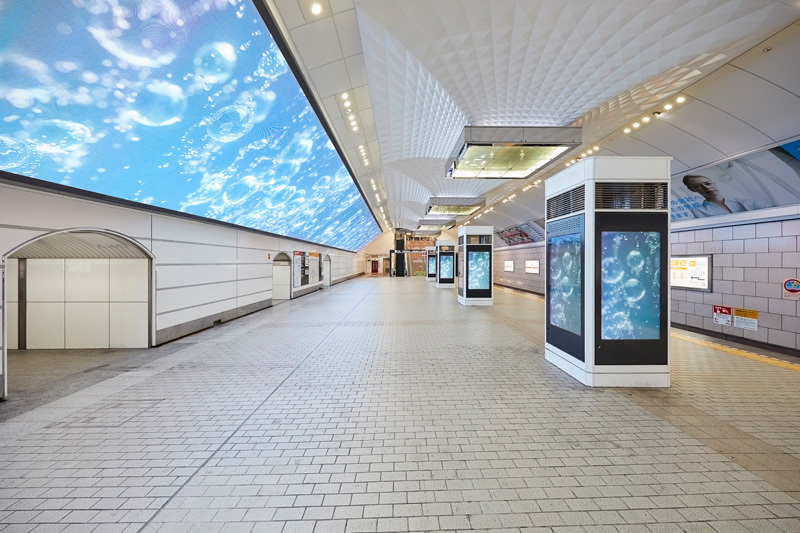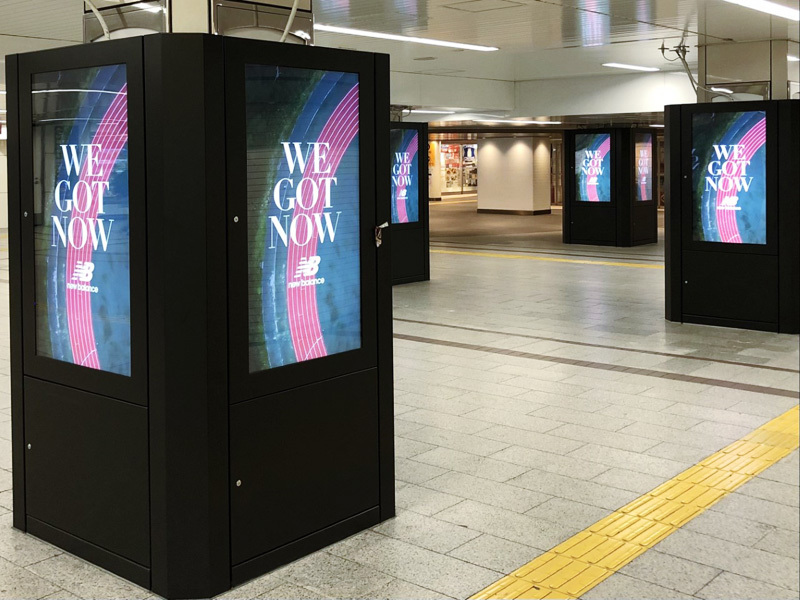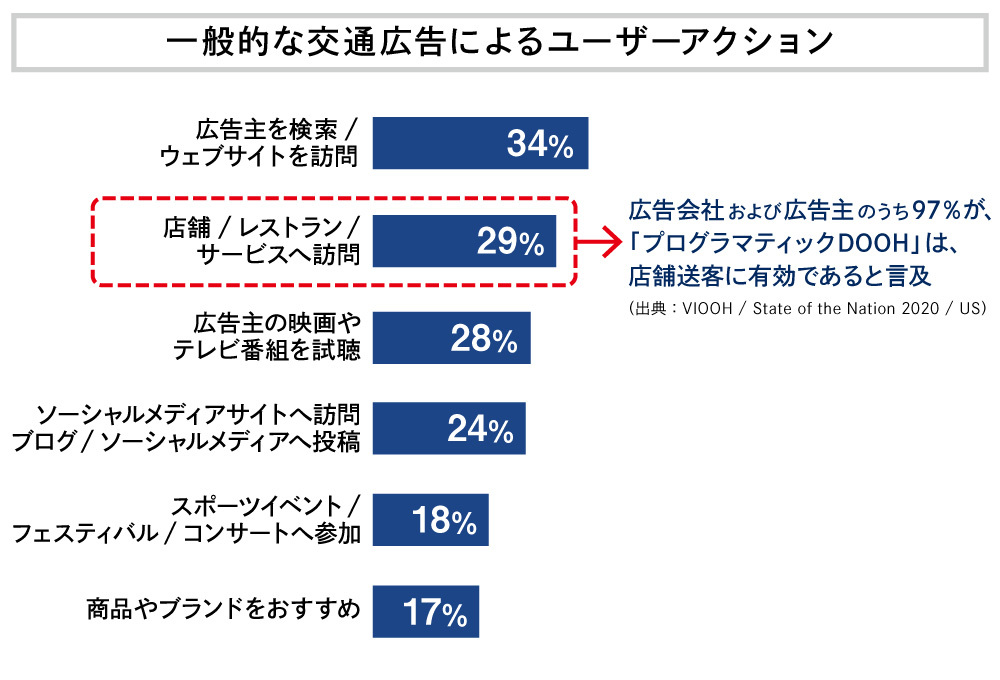Note: This website was automatically translated, so some terms or nuances may not be completely accurate.
OOH in Station Facilities: Leading the Way in Digital Display
Station concourses feature various posters and signage, but digital advertising is increasingly common, especially in urban stations. Traditionally, OOH (Out Of Home: outdoor and transit advertising) within stations involved selecting fixed display locations for ads shown over set periods.
However, recent efforts are advancing "programmatic OOH," which allows for flexible changes to displayed ads based on visibility data and other metrics. What exactly is "programmatic OOH"? We spoke with Takafumi Arai, Digital Manager at Osaka Metro Adella (*1), the company responsible for the Osaka Metro Group's advertising business, about their initiatives.
※1 Osaka Metro Adela: An advertising company that delivers information precisely to people accessing Osaka Metro Group stations, trains, and facilities along their real-life commutes.

Utilizing data to efficiently deliver station advertising
──First, could you explain the background behind deciding to introduce "programmatic OOH"?
Osaka Metro Group and Osaka Metro Service (which transferred its advertising business to Osaka Metro Adella on April 1, 2021) were lagging behind the digitalization of society. Our transition to DOOH (Digital Out Of Home: advertising using digital signage) for analog media was also slower than other railway companies. When digitizing OOH in trains and stations, we considered implementing "Programmatic OOH"—not just displaying ads digitally, but leveraging digital measurement and data—to deliver ads more efficiently.
"ProgrammaticOOH"refers to...
DOOH that connects multiple advertising slots into a network, automating transactions and ad delivery. While measuring impressions (the number of times an ad is displayed), the media currency (value standard in media transactions), is straightforward for one-to-one digital ads, one-to-many OOH requires using data to estimate impressions and reach (the number of unique users who saw the ad) for the target audience.
Within OOH, a brand-safe medium, "Programmatic OOH" enables transactions based on CPM (cost per thousand impressions) for viewable impressions (※2) comparable to other media. It allows audience targeting, offers high cost-effectiveness as advertisers pay for quantifiable impression results, and provides flexible delivery adjustments. This approach can meet advertisers' demands for a certain level of transparency and accountability regarding advertising spend.
※2 Viewable impression: An ad impression that was actually in a state where it could be viewed by the user.

──You mentioned utilizing digital measurement and data. What specific actions are you taking?
When implementing "Programmatic OOH," we first considered utilizing data held within our own group. One source is user data from station ticket gates, which reveals foot traffic near DOOH installations. The second is attribute data derived from PiTaPa, a transportation IC card widely used in the Kansai region, which we extrapolate and estimate. PiTaPa only handles statistical information like gender and age; we do not use any personally identifiable information.
To measure how displayed ads are actually viewed, we utilize eye tracking (*3). We had survey participants wear wearable eye trackers (glasses-type gaze measurement devices). We analyzed information such as which parts of the DOOH they focused on and the duration of their gaze to calculate viewability rates.
By multiplying this viewability rate with our weekly updated group data, we can estimate viewable impressions (※4).
*3 Eye Tracking: A technology that determines where a person is looking based on the position and direction of their eyes. We define "viewing the digital signage" as the moment the gaze shifts and is on the digital signage display. Cases where the gaze happens to pass over the display due to body or head movement are excluded.
※4 The estimation method also complies with the "Audience Measurement Guidelines" issued in March 2021 by the Digital Signage Consortium (DSC), a general incorporated association, which aims to establish standards for measuring DOOH audiences.

Developing a platform for "programmatic OOH"
──So you aimed to incorporate internet advertising methods into DOOH within station premises. Please tell us about your efforts to get advertisers to actually use it.
Even if we say "data preparation enables measurement" or "impressions can be calculated," CPM-based transactions require a platform similar to digital advertising.
First, to enable transactions based on our own data, we built and operated the platform ourselves. While accumulating insights and experience on the advertising effectiveness and utility of "programmatic OOH," we also utilized external data like weather information and explored integration with DSPs (※5).
※5 DSP: Abbreviation for Demand-Side Platform. An advertising delivery tool used by the demand side (advertisers). It provides functions to help advertisers maximize advertising effectiveness.
──What advantages does this offer compared to traditional advertising?
Audience data is updated weekly, so while not real-time, it enables flexible ad delivery to targets based on the latest information. Delivery methods are also flexible—for instance, if many targets are entering the station in the morning, ads can be delivered only to the screens visible during entry. After ad placement, we provide delivery reports per campaign showing impressions, reach, and frequency. Advertisers also benefit from being able to freely set the start date (day of the week) and duration.
A test delivery was conducted in June 2021. New Balance Japan, a sports shoe manufacturer, ran a video ad featuring athlete Nozomi Tanaka for their global brand campaign "We Got Now" ("Run the New Now"). This ad was delivered via Osaka Metro's "Programmatic OOH" simultaneously with its exposure on various SNS platforms, timed to coincide with the track and field competition held in Osaka starting June 24th. During the delivery period until July 11th, it reached 370,000 men and women in their teens and twenties, the targeted demographic.

Quantitative evaluation of advertising effectiveness showed a 6.7-point lift in store visits to New Balance official stores in the Osaka area compared to other regions during the same period. This confirmed the effectiveness of "Programmatic OOH," which 97% of leading advertisers and agencies in Europe and the US cite as effective for driving store traffic. However, we believe further verification is needed regarding its branding and performance advertising effects.

Survey Period: June 24 - July 11, 2021 Survey Target: All New Balance Official Stores nationwide (including outlets) Survey Organization: New Balance Japan
OOH allows for creative tricks that are difficult with TV commercials or smartphone video ads. The OAAA (Out of Home Advertising Association of America, Inc.) released its "Creative Best Practices Guide For OOH Advertising" on September 28th, stating that "75% of advertising effectiveness is determined by creative" and that "OOH is an extremely flexible medium."

We are exploring initiatives with advertisers and agencies, such as "programmatic OOH"—which trades on a CPM basis similar to digital advertising and enables quantitative measurement of impressions and reach—and efforts to measure advertising effectiveness by combining performance metrics like social media impressions and reach. This includes achieving stereoscopic and optical illusion effects through creative expression on flat vertical screens, as well as initiatives linking with AR. Moving forward, we aim to develop initiatives that foster interest in "programmatic OOH," which enables the delivery of flexible, target-specific creative content.

After the interview...
Osaka Metro Adella had been releasing various announcements promoting the digital transformation (DX) of transit advertising, so I was keen to understand the background behind their efforts. What stood out during the interview was their approach to leveraging their own group's data when delivering "programmatic OOH." This approach not only avoids the risk of future unavailability associated with third-party data but also ensures accurate data collection for station usage. Longer term, it could enhance convenience for commuters.
"Programmatic OOH" makes OOH ordering more flexible, moving away from the traditional model centered on fixed-period purchases like weekly blocks. Currently, various railway companies have begun trial sales. The ability to run ads targeting specific audiences only during campaign periods offers significant benefits for clients. I strongly encourage trying this in combination with existing media menus.
Was this article helpful?
Newsletter registration is here
We select and publish important news every day
For inquiries about this article
Back Numbers
Author

Kana Misawa
Dentsu Inc.
Out-of-Home Media Division
After working in creative, sports business, AI chatbot, and healthcare business development, he assumed his current position. He is involved in developing media planning tools centered on OOH and business development in the data and technology domain. Ph.D. (Interdisciplinary Information Studies)



